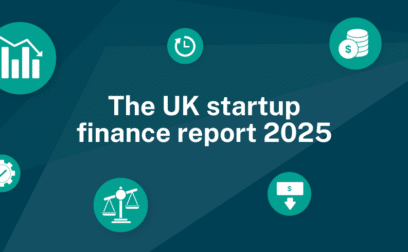TABLE OF CONTENTS
Secure your corporate finance with Swoop








Page written by Chris Godfrey. Last reviewed on August 12, 2025. Next review due April 6, 2027.

Corporate finance is central to business success, guiding decisions on investments, funding, and resource management to drive growth and profitability. In the UK, it underpins the economy by enabling companies to access capital, innovate, and expand, supporting jobs, trade, and the financial sector’s contribution to national output.
‘Corporate finance’ is a catchall term that refers to the activities and strategies businesses use to manage their money, fund growth, and maximise shareholder value. This includes raising funds through equity (issuing shares), debt (taking out loans or issuing bonds), as well as making investment decisions and managing financial risks.
Typically used by larger companies, the government and various advisory firms, corporate finance is closely associated with major business transactions such as mergers and acquisitions, management buy-outs, public listings via IPOs, and restructuring or refinancing existing debt. The field also involves working capital management, ensuring companies have sufficient liquidity for day-to-day operations, and advising on strategic financial decisions. In the UK, corporate finance is often transactional, focusing on structuring deals to create, develop, or acquire businesses, and it’s regulated by authorities such as the Financial Conduct Authority (FCA).
Corporate finance is vital for UK businesses as it underpins their ability to grow, remain competitive, and ensure long-term sustainability. By providing tools and strategies for managing capital, corporate finance enables companies to make informed decisions about investment, funding, and expenditures – allowing businesses to allocate resources efficiently, seize growth opportunities, and mitigate potential risks.
Moreover, corporate finance helps businesses optimise their capital structure—balancing debt and equity to minimise costs and maximise value. This is essential for maintaining healthy cash flow, supporting day-to-day operations, and preparing for expansion or unforeseen challenges. For both large corporations and SMEs, corporate finance is the cornerstone for achieving financial stability, attracting investors, and driving profitability.
Large businesses, mid-sized businesses, organisations planning complex financial and strategic transactions – corporate finance can help many types of business and in almost any circumstance.
Corporate finance helps large enterprises optimise their capital structure by balancing debt and equity, thereby reducing the overall cost of capital and supporting ambitious investment strategies. It facilitates access to substantial funding—such as issuing bonds or securing large loans—for major projects, international expansion, or M&A activity. Large firms also use corporate finance to manage risk, improve financial stability, and maximise shareholder value through disciplined capital allocation and robust financial planning.
For growing mid-sized companies, corporate finance is vital for fuelling expansion, managing cash flow, and investing in new opportunities. It provides the necessary liquidity to invest in infrastructure, technology, and workforce, which supports scaling operations and entering new markets. Flexible financing options, such as working capital loans or asset finance, can help mid-sized firms to maintain steady growth, strengthen their balance sheets, and enhance their creditworthiness.
Corporate finance is essential for businesses planning mergers, acquisitions, or expansion, as it supports the structuring, valuation, and funding of these complex transactions. It enables companies to raise capital for deals, assess risks and returns, and optimise deal terms to maximise value. Corporate finance can also help to manage integration costs, ensuring smooth post-transaction operations and better positioning the business for long-term success.
Corporate finance is a wide-ranging topic, and it can vary from the very simple to the highly complex. However, regardless of the financial instruments used or strategies deployed, one or more of the following components will typically be involved.
Capital structure concerns the mix of debt and equity used by a company to fund its operations and growth. There is no universal formula for the right mix; the optimal blend depends on the business’s nature, where it’s at in its lifecycle, and its strategic objectives. Funding strategies may involve raising capital through bank loans, issuing bonds (debt), or selling shares (equity), each with different implications for cost, risk, and control. Companies will aim to balance these sources to minimise their weighted average cost of capital (WACC) – the average rate a company expects to pay to finance its assets – while managing financial risk and maintaining flexibility for growth.
Financial planning and analysis (FP&A) allows businesses to forecast future financial performance, allocate resources efficiently, and support decision-making. This process includes budgeting, cash flow projections, and scenario analysis to ensure the business can meet its financial obligations and invest in profitable opportunities. FP&A helps companies identify the most effective use of their money, anticipate challenges, and adapt to changing market conditions.
Risk management in corporate finance involves identifying, assessing, and mitigating financial risks that could impact a company’s stability or profitability. This includes managing interest rate risk, credit risk, liquidity risk, and operational risk. Effective risk management ensures companies can withstand economic downturns, meet debt obligations, and protect shareholder value. Strategies may include hedging, insurance, diversification, and maintaining adequate liquidity buffers.
Investment and asset management focus on how a company deploys its capital to generate returns and support growth. This includes evaluating and selecting investment opportunities, such as new projects, acquisitions, or technology upgrades, as well as managing existing assets to maximise their value. Good asset management ensures resources are allocated efficiently to support the company’s long-term strategic objectives and enhance overall financial performance.
Corporate finance can come in many shapes and sizes, but the strategies and financial tools employed will usually fall into one of the categories below.
Equity financing is a method of raising capital by selling shares in a business to investors, who then gain part ownership and a share in future profits or losses. This approach allows businesses to access funds without incurring debt or making regular repayments, making it particularly attractive for startups and growing companies. Investors may include angel investors, venture capitalists, or private equity firms, and sometimes the general public through an IPO.
Equity financing supports business growth, funds new projects, and can bring valuable expertise and networks from investors. Many UK businesses use a mix of equity and debt financing to optimise their capital structure.
Debt financing is when a business borrows money to fund its operations or growth, agreeing to repay the principal plus interest over time. Common sources include bank loans, peer-to-peer lending, startup loans, overdrafts, credit cards, and lines of credit. Unlike equity financing, debt financing does not require giving up any business ownership
Businesses use debt finance for a range of purposes such as purchasing equipment, expanding operations, or managing cash flow. The choice of debt product depends on the business’s needs, creditworthiness, and the level of risk it is willing to take. Repayment terms and interest rates vary by lender and loan type. Security may be required.
Mezzanine financing is a hybrid funding solution that combines elements of debt and equity. It is often used to bridge the gap between senior loans and owner equity for growth, acquisitions, or buyouts. This type of funding is typically unsecured, subordinated to senior debt, and may include equity features such as warrants or conversion rights, where, if the borrower defaults, the lender can convert the loan into company shares. Mezzanine finance may give businesses access to larger sums than traditional loans. It typically offers flexible repayment terms and is repaid after senior debt but before equity in cases of insolvency.
Structured finance is a sophisticated financial solution to complex financing needs that conventional financial products such as small business loans or mortgages cannot satisfy. Structured finance is primarily utilised by large corporations or institutions requiring substantial capital or tailored solutions for unique projects or risk management. The core mechanism of structured finance is securitisation – (collateralisation) – which involves pooling together various financial assets, such as loans, mortgages, or receivables, into a single entity, often a Special Purpose Vehicle (SPV). The SPV issues securities backed by the pooled assets, which are then sold to investors to raise new capital.
Mergers and acquisitions (M&A) support refers to the expert advisory services that help businesses plan, execute, and integrate transactions involving the buying, selling, or merging of companies.
Businesses use M&A support to identify suitable target companies, conduct due diligence, negotiate terms, and ensure regulatory compliance with UK laws such as the Companies Act and the Takeover Code. This type of support can help companies to expand market share, enter new sectors, achieve cost efficiencies, and leverage synergies. Specialist firms are usually employed to provide strategic guidance, financial analysis, and operational assistance throughout the transaction lifecycle, helping businesses maximise value and minimise risk.
A management buyout occurs when the existing management team of a business purchases all or part of the company from its current owners. The management team, often with the support of external financing from banks, private equity firms, or vendor financing, acquires a controlling stake, becoming the new owners and taking over the responsibilities and risks associated with running the business. This process is commonly chosen by business owners who wish to exit or retire and prefer to sell to a team that already understands the company’s operations.
A management buy-in, by contrast, involves an external management team purchasing a controlling interest in a business and replacing its existing management. The incoming team typically has industry experience but limited or no prior involvement with the specific company. MBIs are often pursued when a business is underperforming, lacks succession planning, or requires fresh expertise to unlock its full potential. The new management may bring in additional funding, new strategies, or access to new markets. Once again, external financing from banks, private equity firms, or specialist lenders is often employed to bolster the MBI team’s financial resources and complete the sale.
orporate finance and small business finance may sound like two sides of same coin, but there are significant differences between these fields of finance.
Corporate finance is typically associated with large corporations, who operate on a much larger scale and with far greater complexity than small businesses. These organisations often have multiple business units, international operations, and sophisticated financial structures involving subsidiaries and complex reporting requirements. Corporate finance professionals use advanced financial models and strategic planning to manage these complexities.
In comparison, small business finance is focused on smaller firms with limited budgets and fewer resources. Financial management in small businesses is often handled by the owner or a small team, using simpler processes and less formalised reporting. The scale of operations and the number of stakeholders involved are thus much smaller and less complex.
Large corporations access a wide range of financial instruments to support their growth and operations. These include issuing corporate bonds, raising equity through stock offerings, and utilising complex debt instruments such as syndicated loans or commercial paper. They may also engage in mergers and acquisitions, management buyouts, and structured finance solutions to optimise their capital structure.
Small businesses, on the other hand, rely on more straightforward funding sources such as personal savings, bank loans, lines of credit, and sometimes grants or funds from local investors. Their financial instruments are generally less sophisticated and more focused on meeting immediate cash flow needs.
The strategic goals of corporate finance are centred on maximising shareholder value through long-term growth, profitability, and efficient capital allocation. This includes boosting stock prices, achieving high returns on investment, and optimising the balance between debt and equity to minimise the cost of capital. Corporate finance teams also focus on managing corporate risk and ensuring sustainable profits for a broad base of stakeholders.
By contrast, small business finance prioritises practical cash flow management, maintaining working capital, and controlling expenses to ensure day-to-day operational efficiency and survival. The goals for small businesses are typically more immediate and focused on steady growth, profitability, and maintaining a robust market position, rather than maximising shareholder value on a large scale.
Like most financial products, corporate finance solutions have their advantages and disadvantages:
Selecting the best corporate finance strategy for your business is crucial for success. Here are the key steps to get you there:
To choose the right corporate finance strategy, begin by ensuring it aligns closely with your company’s growth objectives. Define clear, measurable goals—preferably using the SMART framework (Specific, Measurable, Achievable, Relevant, Time-bound)—and establish KPIs that track financial and operational progress. This alignment guarantees that every financial decision supports your broader mission and drives sustainable expansion. Regularly review and adjust your financial plans to stay responsive to changing business needs and market opportunities.
A sound corporate finance strategy requires balancing potential returns against associated risks. Assess your company’s risk tolerance and investment horizon before making key decisions. Higher-risk investments may offer greater returns but can also lead to significant losses; conversely, lower-risk options provide more stability but typically yield smaller gains. Diversification and asset allocation are key tools for managing this balance, helping to spread risk across different investments while aiming for optimal returns. Use financial models and frameworks like CAPM to evaluate how different choices align with your risk-return profile.
Engaging experienced corporate finance advisors can be invaluable. They provide strategic guidance, help you navigate complex transactions (such as mergers, acquisitions, or capital raising), and offer objective valuations and risk assessments. Advisors bring deep sector knowledge, access to investor networks, and project management skills, all of which facilitate smoother deal execution and better outcomes. Always choose an advisor who understands your business objectives, communicates clearly, and has a proven track record in your industry.
Accessing corporate finance support involves a mix of government resources, specialist advisory firms, and tailored finance solutions. The UK government provides free advice, business planning support, and access to a directory of approved finance suppliers for businesses at all stages—from startups to established companies. Workshops, one-to-one advisory sessions, and grants are available regionally, with specific support for SMEs and growth-oriented businesses.
For more complex needs, businesses may need to engage with corporate finance advisory firms who offer services including business valuation, funding searches, deal negotiation, and strategic growth planning. These firms can provide access to funds, market connections, and independent advice tailored to your business objectives.
Working with business finance experts can make all the difference when applying for funding. Contact Swoop to discuss your financial needs, get help with your application and to compare high-quality corporate finance deals from a choice of providers. Think big, grow bigger. Register with Swoop today.
Written by
Chris is a freelance copywriter and content creator. He has been active in the marketing, advertising, and publishing industries for more than twenty-five years. Writing for Barclays Bank, Metro Bank, Wells Fargo, ABN Amro, Quidco, Legal and General, Inshur Zego, AIG, Met Life, State Farm, Direct Line, insurers and pension funds, his words have appeared online and in print to inform, entertain and explain the complex world of consumer and business finance and insurance.
Swoop promise
At Swoop we want to make it easy for SMEs to understand the sometimes overwhelming world of business finance and insurance. Our goal is simple – to distill complex topics, unravel jargon, offer transparent and impartial information, and empower businesses to make smart financial decisions with confidence.
Find out more about Swoop’s editorial principles by reading our editorial policy.
Related pages
Get your free Corporate finance quote today
Join the 110,000+ businesses just like yours getting the Swoop newsletter.
Free. No spam. Opt out whenever you like.



























We work with world class partners to help us support businesses with finance
Kingfisher Way, Silverlink Business Park, Newcastle upon Tyne, NE28 9NX, UK
View in Google MapsAberystwyth Innovation and Enterprise Campus
Gogerddan Campus
Aberystwyth University
Ceredigion
SY23 3EE
Dogpatch Labs, The CHQ Building, Custom House Quay, Dublin, Ireland
View in Google MapsSuite 801, Level 8, 84 Pitt Street, Sydney, NSW 2000, Australia
View in Google Maps43 W 23rd St, New York, NY 10010, United States
View in Google Maps21 Dreyer Street, Cape Town, South Africa, 7708
View in Google Maps
Disclaimer: Swoop Finance helps UK firms access business finance, working directly with businesses and their trusted advisors. We are a credit broker and do not provide loans or other finance products ourselves. We can introduce you to a panel of lenders, equity funds and grant agencies. Whichever lender you choose we may receive commission from them (either a fixed fee of fixed % of the amount you receive) and different lenders pay different rates. For certain lenders, we do have influence over the interest rate, and this can impact the amount you pay under the agreement. All finance and quotes are subject to status and income. Applicants must be aged 18 and over and terms and conditions apply. Guarantees and Indemnities may be required. Swoop Finance can introduce applicants to a number of providers based on the applicants’ circumstances and creditworthiness. Swoop Finance Limited is registered with the Financial Conduct Authority as an Account Information Services Provider (reference number 833145). Swoop Finance Limited is authorised as a credit broker under FCA registration number 936513. If you feel you have a complaint, please read our complaints section highlighted above and also contained within our terms and conditions. Swoop Finance Ltd is registered with Companies House (company number 11163382, registered address The Stable Yard, Vicarage Road, Stony Stratford, Milton Keynes MK11 1BN). VAT number: 300080279
Clever finance tips and the latest news
Delivered to your inbox monthly
Join the 110,000+ businesses just like yours getting the Swoop newsletter. Free. No spam. Opt out whenever you like.
Thanks for requesting a call back
a member of the team will be in touch.




